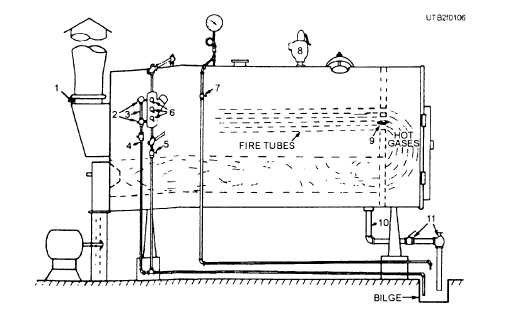
Figure 1-6. - Boiler fittings.
or device not covered in this text, check the manu- facturer's manual for information on details of its construction and method of operation.
The term fittings include various control devices on the boiler. Fittings are vitally important to the economy of operation and safety of personnel and equipment. You must understand fittings if you are to acquire skill in the installation, operation, and servicing of steam boilers.
All boilers require boiler fittings to operate safely. The American Society of Mechanical Engineers (ASME) requires all boiler fittings to be made of materials that withstand the pressure and temperatures that boilers are subject to. All of the boiler fittings discussed are important and must be operated and maintained properly to operate a boiler safely.
AIR COCK
An air cock is located in the uppermost steam space of a boiler, as shown in item 7 in figure 1-6. This design allows for air to enter and escape during filling and draining of the boiler. Before firing a cold boiler with no steam pressure, the air cock is opened to allow air to escape during the heating of the water. When steam begins to come out of the air cock piping, close the valve.
CHIMNEYS, DRAFT FANS, AND BREECHINGS
Chimneys are necessary for discharging the products of combustion at an elevation high enough to comply with health requirements and to prevent a nuisance because of low-flying smoke, soot, and ash. A boiler needs a draft to mix air correctly with the fuel supply and to conduct the flue gases through the complete setting. The air necessary for combustion of fuel cannot be supplied normally by a natural draft. Therefore, draft fans may be used to ensure that the air requirements are properly attained. Two types of draft fans used on boilers are forced-draft and induced-draft fans. They are damper controlled and usually are driven by an electric motor.
The FORCED-DRAFT fan forces air through the fuel bed, or fuel oil burner, and into the furnace to supply air for combustion. The INDUCED-DRAFT fan draws gases through the setting, thus facilitating their removal through the stack. Breechings (see item 1 in fig. 1-6) are used to connect the boiler to the stack. They are usually made of sheet steel with provision for expansion and contraction. The breaching may be carried over the boilers, in back of the setting, or even under the boiler room floor. Keep breechings as short as possible and free from sharp bends and abrupt changes in area. The cross-sectional area should be approximately 20 percent greater than that of the stack to keep draft loss to a minimum. A breaching with a circular cross section causes less draft loss than one with a rectangular or square cross section.
BLOWDOWN VALVES
Blowdown valves on boilers are located on the water column and on the lowest point of the water spaces of the boiler (see items 2, 5, 10, and 11 in fig. 1-6). The blowdown valves on a boiler installed at the bottom of each water
Continue Reading